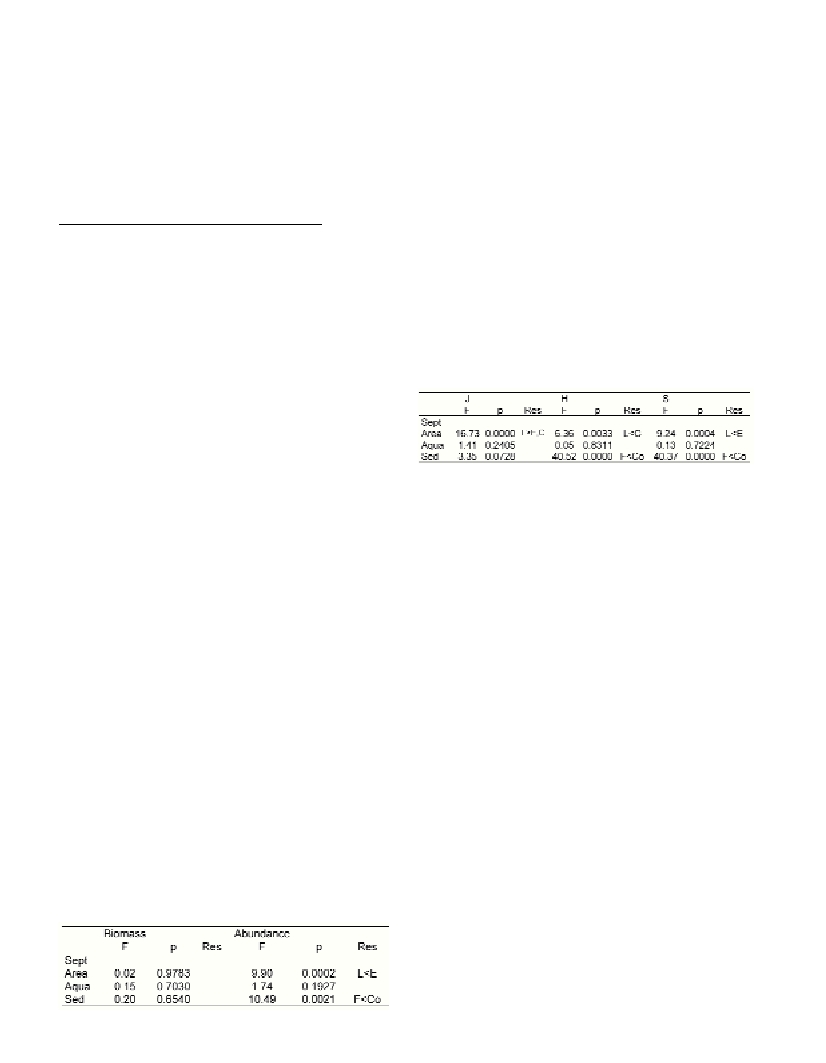MESOSCALE EFFECTS OF FISH FARMING ZONES ON MACROBENTHIC COMMUNITIES
IN THE AEGEAN SEA
Karakassis I.
1*
, Papadopoulou K.N.
1
, Apostolaki E.
1
and D. Koutsoubas
2
1
Inst. of Marine Biology of Crete, Heraklion, Hellas - * jkarak@imbc.gr
2
Dept. Marine Sciences, University of the Aegean, Mytilene, Hellas
Abstract
The effect of fish farming zones on the marine benthic communities over mesoscales (1-10 km) was investigated in three coastal areas of
the Aegean Sea. The results showed that there were no significant changes between sites close to and far from the fish farming zones in
terms of abundance, biomass and diversity.
Key words: aquaculture, fish farming zones, benthos
Rapp. Comm. int. Mer Médit., 37,2004
377
Introduction
The benthic effects of fish farming in the vicinity of fish cages have
been documented from several parts of the world including the
Mediterranean [1,2]. However, the expansion of fish farming has
resulted in the development of large zones with considerable produc-
tion and therefore with significant release of nutrients. Although the
dispersive character of the sites selected for fish farming induces rapid
water renewal it could be expected that the amount of nutrients and
fine particulate material released could directly or indirectly disturb
marine biota over larger spatial scales. Even more so in the case of
oligotrophic marine systems such as the Mediterranean where the sig-
nal of nutrient enrichment should be more readily detectable over
larger spatial scales. The present study was designed to test the
hypothesis that macrofaunal communities are in?uenced by fish farm-
ing zones at spatial scales of 1-10 km.
Materials and methods
Three areas in the Aegean Sea (Evoia, Chios and Lesvos islands)
were sampled during September 2002, during the period of maximal
feed supply. In each region, one sub-area near the zone of fish farm-
ing activity (thereafter referred to as “fish-farm site”) as well as one
sub-area far away from these zones (thereafter referred to as “refer-
ence site”) were investigated. Reference sites had comparable topog-
raphy, depth and an average distance of 20 nautical miles (nm) from
the respective fish-farm sites. At each site 10 random replicates were
taken by means of a 0.1 m
2
Smith-McIntyre grab. Specimens were
sieved over a 0.5 mm sieve, fixed with formalin 10% and identified
into species level. Sediment redox potential (Eh), total organic carbon
and nitrogen (TOC, TON), chlorophyll a and phaeopigments were
determined for each replicate. Diversity was determined by means of
PRIMER software and comparisons between sites, sediment types
and proximity to fish farming zones were performed by means of 3-
way ANOVA.
Results and discussion
In the 60 samples analyzed, a total of 9077 individuals were found
belonging to 334 species. The results of the 3-way ANOVA (Table 1)
for abundance and biomass, showed no significant changes in biomass
in respect of any of the variables examined, whereas abundance
showed significant changes in response to sediment type and area but
no significant differences in response to proximity to fish farming
zones. All the measures of diversity employed (Table 2) namely
Shannon index (H’), evenness (J) and number of species per sample
(S) also showed significant changes among areas and types of sedi-
ments but again with no significant changes in response to proximity
to fish farming zones. Our results indicate that fish farming zones
examined under the present levels of production and at the present
scheme of site selection procedures do not impose significant changes
on macrofaunal community attributes. Although fish farming releases
considerable amounts of nutrients in the water column [3] it seems
that these do not affect the productivity in a way that could negative-
ly affect the benthic environment beyond the zone at the immediate
vicinity of the farms.
Table 2. ANOVA table for diversity indices (J, H, S) from abundance data
per area (E:Evia, L: Lesvos, C:Chios), aquaculture presence (Aqua) and
substratum type (sed). F: value of F-test, p: the probability value (signif-
icant values in bold). Res: results (when significant differences only), N:
Near, F: Far, Co: coarse, Fi: Fine sediments.
References
1-Karakassis I., Tsapakis M., Hatziyanni E., Papadopoulou K.N. and
Plaiti, W., 2000. Impact of cage farming of fish on the seabead in three
Mediterranean coastal areas. ICES J. Mar. Sci. 57: 1462-1471.
2-Fernandes T.F., Eleftheriou A., Ackefors H., Eleftheriou M., Ervik A.,
Sanchez-Mata A., Scanlon T., White P., Cochrane S., Pearson T.H. and
Read P.A., 2001. The scientific principles underlying the monitoring of the
environmental impacts of aquaculture. J. Appl. Ichthyol. 17: 181-193.
3-Pitta P., Karakassis I., Tsapakis M. and Zivanovic S., 1999. Natural vs
mariculture induced variability in nutrients and plankton in the Eastern
Mediterranean. Hydrobiologia391: 181-194.
Table 1. ANOVA table for total macrofaunal biomass and abundance per
area (E:Evia, L: Lesvos, C:Chios), aquaculture presence (Aqua) and sub-
stratum type (sed). F: value of F-test, p: the probability value (significant
values in bold). Res: results (when significant differences only), N: Near,
F: Far, Co: coarse, Fi: Fine sediments.

